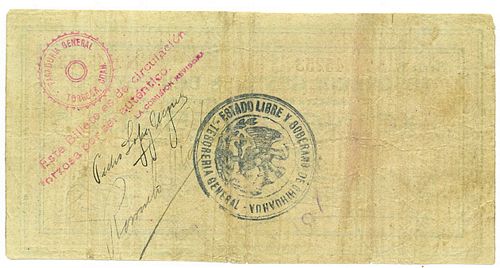Resellos on sábanas - North East Mexico
Torreón – Pagaduría General
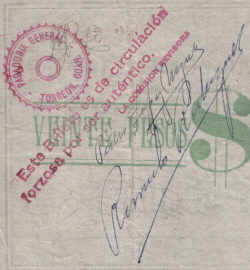 A small (24mm) red or blue circular rubber stamp with inscription ‘PAGADURIA GENERAL - TORREON, COAH.’ and, below, a three line inscription ‘Este Billete es de circulación forzosa por ser auténtico. LA COMISION REVISORA’ followed by handwritten signatures (Pedro López Negrete and Romulo Rodríguez).
A small (24mm) red or blue circular rubber stamp with inscription ‘PAGADURIA GENERAL - TORREON, COAH.’ and, below, a three line inscription ‘Este Billete es de circulación forzosa por ser auténtico. LA COMISION REVISORA’ followed by handwritten signatures (Pedro López Negrete and Romulo Rodríguez).
This resello was also applied to brand new notes before they were put into circulation.
Torreón, near the southwest border of Coahuila and separated from Gómez Palacio, Durango, by the Nazas river, was a vital junction throughout the revolution. Together with Gómez Palacio and Lerdo it makes up the Comarca Lagunera.
Villa occupied Torreón in April 1914, driving the Federal troops and six to seven thousand Spaniards out of the city. The authorities in Torreón were already restamping Chihuahua notes by November 1914ADU, Sección de Hacienda p178, telegram of Governor Saravia of Durango to Villa, 17 November 1914. By March 1915 because of the overwhelming number of forgeries in circulation Villa set up an office under control of the Comandancia Militar de la Comarca to sort out the genuine from the counterfeit with dramatic effectsACOAH, sección 31a, exp. 11735 correspondence between Governor and Comandante Militar Ramírez, Mayor Jefe de Estado Mayor Rodolfo Farías Flores and Francisco Escudero, Chihuahua, 6 March and 8 March 1915.
Torreón was retaken by the Carrancistas on 29 September 1915.
Torreón – Ferrocarriles Constitucionalistas
A round black stamp with ‘F.F.C.C. Constitucionalistas de Mexico, Torreon, Coah.’
Carranza took over control of the railways in December 1914 and the title ‘Ferrocarriles Constitucionalistas’ dates from this time.
Brigada Robles – Comandancia

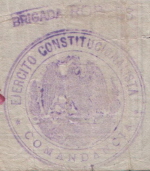 A large (44mm) round violet stamp with ‘EJERCITO CONSTITUCIONALISTA – COMANDANCIA’ and eagle in centre. Above the circle is the inscription ‘BRIGADA ROBLES’.
A large (44mm) round violet stamp with ‘EJERCITO CONSTITUCIONALISTA – COMANDANCIA’ and eagle in centre. Above the circle is the inscription ‘BRIGADA ROBLES’.
On 26 March 1914 the Brigada Robles (1,500 men under General José Isabel Robles) arrived at Vergel on the Central Railway, five miles north of Gómez Palacio. It joined in the attacks on Gómez Palacio and Torreón. On 3 April it left Torreón for San Pedro de las Colonias. By 14 May it was at Sauceda (on the railway from Torreón to Monterrey) and on 23 June it was in the attack on Zacatecas (by this time commanded by General Eugenio Aguirre Benavides since Robles remained wounded at Torreón).
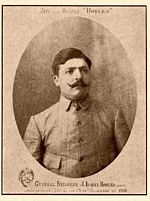 José Isabel Robles Viramontes was born in Jalpa, Zacatecas, on 26 December 1891. After studying elementary school, he enrolled in the Seminary of Zacatecas, which he left in 1909, to join his family in Torreón, Coahuila where he worked as an accountant (rayador) on the Tebas and Palmyra haciendas, With Huerta’s coup d'état he rose up in arms in San Juan de Guadalupe, Durango and joined Carranza in an attack on Torreón, without managing to seize the town. He joined Francisco Villa's forces marching on Torreón and participated in its occupation on 15 October 1913. He then occupied the Coahuila towns of General Cepeda and Parras, and fought the federals at Gómez Palacio and Torreón. He participated in the capture of San Pedro de las Colonias, Coahuila, on 13 April and after overcoming weak resistance from the federals, occupied Saltillo on 20 May 1914. With others commanders of the División del Norte, he marched on Zacatecas but he did not take part in the final battle of 23 June. He took part in the conferences at Torreón, in order to avoid the rupture between Villa and Carranza and signed the Pact of 8 July. During the Convention of Aguascalientes, he was appointed Secretary of War and Navy of the government emanating from it. In January 1915 he left Mexico City together with President Gutiérrez, when it was attacked by Carrancistas and Villistas. A considerable portion of the Brigada Robles refused to follow their commander, remained loyal to Villa and joined in the attack on Guadalajara in April 1915. Robles was completely defeated in actions at Palomas and Cárdenas, San Luis Potosí. He surrendered to the Constitutionalists and was commissioned to fight the Felicista rebels in the state of Oaxaca. He joined General Guillermo Meixueiro, along with 800 men. He was taken prisoner and shot, in the city of Oaxaca on 2 April 1917.
José Isabel Robles Viramontes was born in Jalpa, Zacatecas, on 26 December 1891. After studying elementary school, he enrolled in the Seminary of Zacatecas, which he left in 1909, to join his family in Torreón, Coahuila where he worked as an accountant (rayador) on the Tebas and Palmyra haciendas, With Huerta’s coup d'état he rose up in arms in San Juan de Guadalupe, Durango and joined Carranza in an attack on Torreón, without managing to seize the town. He joined Francisco Villa's forces marching on Torreón and participated in its occupation on 15 October 1913. He then occupied the Coahuila towns of General Cepeda and Parras, and fought the federals at Gómez Palacio and Torreón. He participated in the capture of San Pedro de las Colonias, Coahuila, on 13 April and after overcoming weak resistance from the federals, occupied Saltillo on 20 May 1914. With others commanders of the División del Norte, he marched on Zacatecas but he did not take part in the final battle of 23 June. He took part in the conferences at Torreón, in order to avoid the rupture between Villa and Carranza and signed the Pact of 8 July. During the Convention of Aguascalientes, he was appointed Secretary of War and Navy of the government emanating from it. In January 1915 he left Mexico City together with President Gutiérrez, when it was attacked by Carrancistas and Villistas. A considerable portion of the Brigada Robles refused to follow their commander, remained loyal to Villa and joined in the attack on Guadalajara in April 1915. Robles was completely defeated in actions at Palomas and Cárdenas, San Luis Potosí. He surrendered to the Constitutionalists and was commissioned to fight the Felicista rebels in the state of Oaxaca. He joined General Guillermo Meixueiro, along with 800 men. He was taken prisoner and shot, in the city of Oaxaca on 2 April 1917.
This Brigada Robles resello is found alongside the Torreón and Parras de la Fuente resellos.
San Pedro de las Colonias – Jefatura de Armas
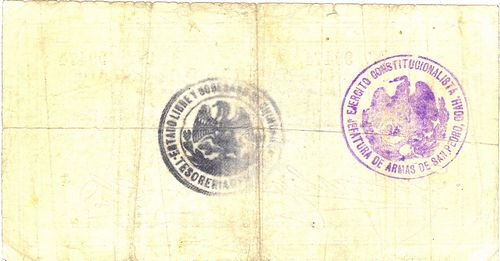
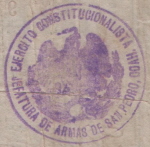 A round (42mm) red or violet stamp with ‘EJERCITO CONSTITUCIONALISTA - JEFATURA DE ARMAS DE SAN PEDRO, COAH.’ and eagle in centre.
A round (42mm) red or violet stamp with ‘EJERCITO CONSTITUCIONALISTA - JEFATURA DE ARMAS DE SAN PEDRO, COAH.’ and eagle in centre.
San Pedro de las Colonias is a city in the southwestern part of Coahuila, 56 kilometres north of Torreón.
After Torreón Villa’s División del Norte moved eastwards along the railway and on 10 April 1914 won a battle at San Pedro against the Federal General Velasco.
This resello probably dates from October 1914 as on 15 June 1915 Jesús Lechuga, Tesorero Municipal of San Pedro de las Colonias, wrote to the governor of Coahuila complaining that the Recaudador de Rentas had returned $465 Villista notes that the Tesorería General had refused as counterfeit, even though all had a resello. Most of these had been revalidated by the Jefatura de Armas in San Pedro, when it carried out a revision in October 1914, had been freely circulating since then and had been taken in in good faith by the municipal treasuryACOAH, Fondo Siglo XX, 1915, caja 14, folleto 5, exp. 7. On 17(?) June 1915, Lechuga took $2,090 in notes to the Oficina Revisora y Reselladora de Billetes in Torreón to be checked (ACOAH, Fondo Siglo XX, 1915, caja 14, folleto 5, exp. 7).
On 6 February 1915 the Comandante Militar in Torreón wrote to the governor of Durango that he had received a complaint from the General Treasurer of the Ferrocarriles Constitucionalistas (Constitutionalist Railways) that his employees were suffering because merchants of that city(?) were refusing to accept Villista notes restamped in Torreón, San Pedro de las Colonias and other bordering places. Also Durango resellados were not accepted in TorreónThe text is confusing “Se ha dirijido a esta Comandancia Militar de mi cargo, suscrita por el C. Tesorero General de los Ferrocarriles Constitucionalistas, una solicitud pidiendo el remedio del caso para evitar que los empleados de dichas Oficinas resientan graves perjuicios, con motivo de que los comerciantes de esa ciudad se niegan a recibir los bonos llamados “Villistas”, resellados en esta poblacion, asi como en San Pedro y otros lugares limitrofes. Igualmente denuncian el hecho de no quererse aceptar aquí, los bonos resellados en esa”. On 11 February Secretary Gaxiola reported that he had already dictated the necessary measuresADur, gaveta 6, nombre 88.
Parras de la Fuente - Presidencia Municipal

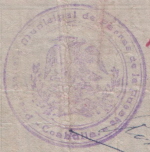 A large (45mm) violet rubber stamp with ‘Presidencia Municipal de Parras de la Fuente - Coahuila.’ and eagle in centre.
A large (45mm) violet rubber stamp with ‘Presidencia Municipal de Parras de la Fuente - Coahuila.’ and eagle in centre.
Parras de la Fuente is located in the southern part of Coahuila.
The Villistas were moving along the railway. After their defeat at Paredon the federals evacuated Saltillo and the rebels occupied it on 20 May 1914.
Use of Villista currency would have spread to other areas of Coahuila. In July the Military Commander of Monclova and the Rio Grande wrote to the Municipal Presidents of Allende and Nava telling them to enforce Villista currencyACOAH, handwritten note, no reference.
Saltillo – [ ]
Saltillo was within Carranza’s sphere of influence (he had been governor of Coahuila), so when tension began between Villa and Carranza, Villista currency fell out of favour. Because of the difficulties over people accepting sábanas on 24 July 1914 the Jefe de Armas in Saltillo, Coronel Severiano Rodríguez, ordered their forced circulation, with a fine of $100 to $500 for anyone who refused themPeriódico Oficial, 1 August 1914. The Villistas took Saltillo on 5 January 1915. Because of the number of counterfeit sábanas in circulation, on 14 January 1915 General Santiago Ramírez, decreed that holders should present them at the Palacio de Gobierno between 9.00 and 12.00 to be checked and revalidated, though only the $5 to $50 values needed to be restampedPeriódico Oficial, 16 January 1915. On 2 February Ramírez’ Jefe del Estado Mayor, Mayor Alfonso Castoreña, announced that the Oficina reselladora was reopened and would remain open until 10 FebruaryPeriódico Oficial, 3 February 1915. On 18 February Castorena announced that the office would definitely close on 25 FebruaryPeriódico Oficial, 20 February 1915.
Monterrey – Renta del Timbre
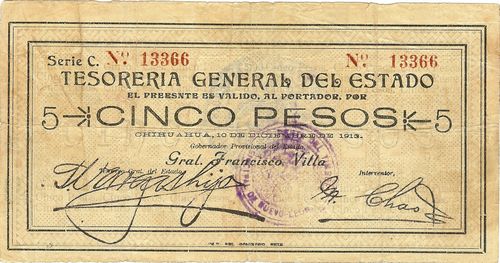
 A round (33mm) violet rubber stamp with inscription ‘RENTA DEL TIMBRE - PBINCIPAL (sic) DE NUEVO-LEON’ and eagle in centre.
A round (33mm) violet rubber stamp with inscription ‘RENTA DEL TIMBRE - PBINCIPAL (sic) DE NUEVO-LEON’ and eagle in centre.
Monterrey was the largest city in northern Mexico and the state capital of Nuevo León. Villista currency was in use there in February 1914CEHM, Fondo MVIII telegram E Calderon, Monterrey to Carranza, Saltillo, 15 February 1914. On 25 May 1914 General Pablo Gonzalez wrote to Villa from Monterrey that there was a large amount of Villista paper currency there. He wanted to know who sent it or how it turned up there (APGG) and by June 1914 Villa was complaining to Carranza that there were difficulties with changing or accepting billetes del Estado de Chihuahua and asked him either to send the Nuevo León government enough Constitutionalist notes to exchange the sábanas, or to order their free acceptance throughout the Constitutionalist territoryCEHM, Fondo MVIII telegram Villa, Torreón to Carranza, Saltillo, 10 June 1914: SD papers, 812.00/12228 telegram Carothers, Saltillo, 13 June 1914. General Antonio I. Villareal, governor of Nuevo León, issued a decree[text needed] informing businesses that they must accept Chihuahua money. Merchants had been trying to avoid accepting any currency except that issued by the central Constitutionalist governmentEl Paso Herald, 13 June 1914. Villareal may have been talking about the dos caritas, not the sábanas.
On 22 April 1915 the Recaudador de Rentas del Estado in Monterrey asked Onofre Zambrano, the Tesorero General, whether the sábanas with the resello of the Administración Principal were still accepted. Zambrano asked the Governor who replied that Chihuahua notes were goodANL, Hacienda y Tesorería, caja 163.
On 9 May 1915 Alfredo H. Hernández, an employee of the Tesorería in Chihuahua, arrived in Monterrey, Nuevo León. He had been summoned by the governor, Raúl Madero, to check the notes in circulation therePrensa, 12 May 1915.

